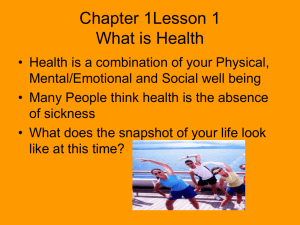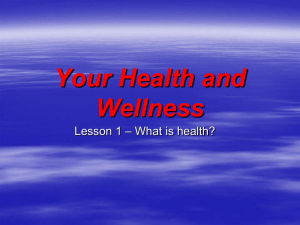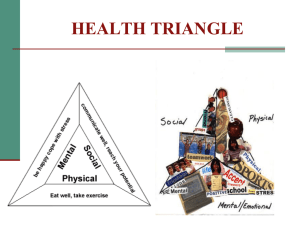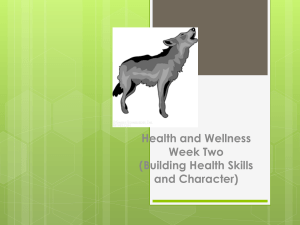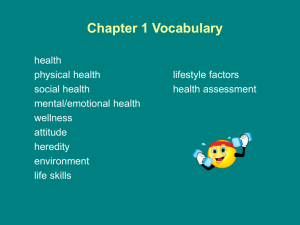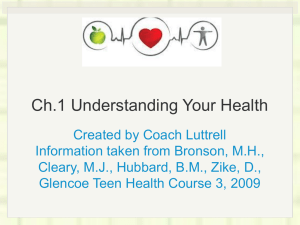Chapter 1 Your Health and Wellness
advertisement
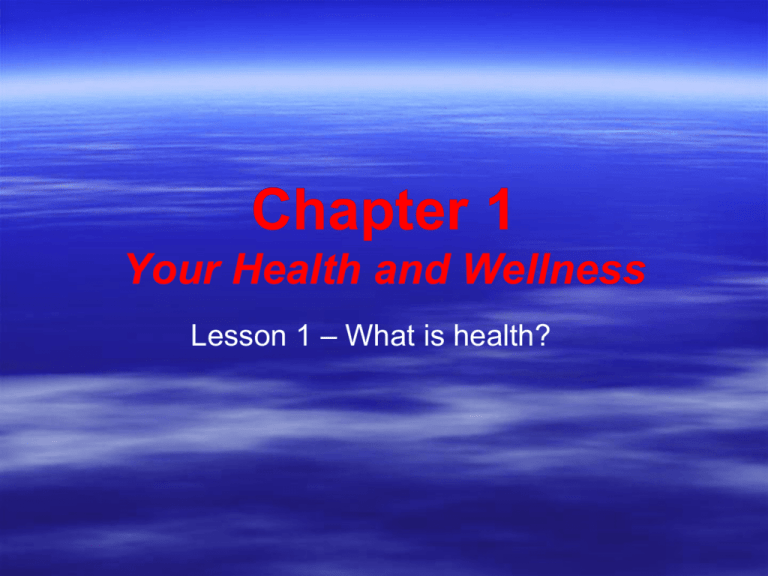
Chapter 1 Your Health and Wellness Lesson 1 – What is health? Chapter 1 Lesson 1 - What is Health? Objectives After this lesson you will be able to: 1. Define Health 2. Describe how the components of health can be represented by a triangle 3. Describe the importance of health education and relate wellness to total health Chapter 1 Lesson 1 - What is Health? 1. 2. Activity 1 - Independent work List several of your favorite activities and hobbies. Then consider how each affects your health Activity 1 - (Continued) Place the following items in the appropriate category/column. Mental/ Emotional Physical Social Stress Management Exercise Conflict/Resolution Skills Find Time to Relax Good Nutrition Seek and Lend Support Exercise Seek and Lend Support Find Time to Relax Conflict/Resolution Skills Good Nutrition Stress Management Where do your activities belong? What is Health? Health is the combination of your physical, mental/emotional, and social well-being. – Your personal level of health affects everything about you. It affects how you look, how you feel, even how you act. – It affects your attitudes and performance in school, work, and recreation. What is Health? (continued) ▪ Your level of health will probably help determine some of your goals and your ability to accomplish them. ▪ It is important to be aware that health is not an absolute state. ▪ Being healthy does not mean that you will never be sick. Instead, being healthy means striving to be the best you can be at any given time. Wellness Wellness is an overall state of wellbeing, or total health Health/Wellness Critical Thinking Question 1 What are the similarities and differences between the two terms? Three Elements of Your Health ▪ ▪ Physical Health Mental and Emotional Health ▪ Social Health Three Elements of Your Health Physical Health Physical health is the way the parts and systems of your body work together. ▪ It means that your body has the ability to cope with stresses of normal daily life. ▪ It means having strength and energy to pursue physical, mental, emotional and social challenges and changes. Three Elements of Your Health Physical Health – Continued Things you can do to maintain physical health: 1. 2. 3. 4. 5. 6. Proper nutrition Regular physical activity Enough rest and sleep Good hygiene to prevent diseases Regular medical and dental checkups Resist harmful substances, such as tobacco alcohol, and other drugs. Three Elements of Your Health Mental and Emotional Health includes your feelings about yourself, how well you relate to others, and how well you meet the demands of daily life. Three Elements of Your Health Mental and Emotional Health Mental Health calls for a person to use their mind to develop thinking skills. People with good mental health enjoy learning and understand it can be an exciting and lifelong process . Emotional Health is a person who is in touch with his or her feelings and expresses them in appropriate, healthful ways. Things you can do to maintain Mental and Emotional Health Mental Health Emotional Health ▪ Strive for information understand it is a process ▪ See mistakes as opportunities to learn, grow, and change ▪ Accept responsibility for your actions ▪ Stand up for your beliefs and values ▪ Dealing with problems and frustrations of life without being overwhelmed ▪ Avoid dwelling on negative thoughts ▪ Consider your negative situations and use positive thoughts and actions to move through the challenge Three Elements of Your Health Social Health involves the way you get along with others. It includes your ability to make and keep friends and also work and play cooperatively Things you can do to maintain social health: 1. 2. 3. Seek and lend support when necessary Communicate well Respect and care for your self and others Three Elements of Your Health Using your responses from Activity 1, List your lifestyle factors and activities next to the appropriate side of the triangle Mental and Emotional Health Social Health Your Health Triangle Physical Health Your Health Triangle The three elements of health are interconnected, like the sides of a triangle. When one side receives too much or too little attention, the other side changes as well. The whole triangle can become lopsided and unbalanced. To be truly healthy, you need to try to keep all three sides of your health triangle – and your lifein balance. The Health Continuum The Health Continuum handout Promoting your health Recent discoveries in medicines and advances in technology have helped wipe out many of the diseases that killed people 100, 50, even 30 years ago. Yet, the way we live today poses new threats to our health and our lives. Millions of people get sick, become disabled, or die each year because of the decisions they make and the way they live. Their decision-making skills and personal behavior are directly related to their deaths. Many of these deaths could be prevented if people practiced a few simple health habits. Lifestyle factors ▪ After years of studying many groups of people, experts have identified seven habits that make a difference in people’s overall health, happiness, and longevity, or how long they live. ▪ People who regularly practice these important habits tend to be healthier and live longer. These habits are called lifestyle factors. ▪ Lifestyle factors are personal behaviors and habits related to the way a person lives, that help determine his or her level of health. Lifestyle factors (continued) The following are important lifestyle factors: 1. 2. 3. 4. 5. 6. 7. Get between seven to eight hours of sleep per night. Eat nutritious foods from the various food groups each day. Refrain from smoking and using tobacco products. Eat breakfast daily. Do 20 to 30 minutes of nonstop vigorous activity a minimum of three times a week. Do not use alcohol or other drugs. Maintain your recommended weight. Your Attitudes, Your Health ▪ Practicing good health habits involves much more than just knowing what to do. Your attitudes also affect how well you take care of yourself. ▪ For example, in order to practice good health habits, you must believe that there is some benefit for you, and that by not practicing good health habits, problems will develop. ▪ You also need to become aware of your overall attitude, or outlook, on life since this can play a major role in both your quality of life and your health. Your Attitudes, Your Health ▪ Studies have shown that optimists, people who tend to see the positive in situations, are less likely to suffer illness and die young than pessimists, those who look for and see the negative in situations. ▪ Other studies have concluded that it is not what happens to a person but the person’s attitudes and responding behaviors that determine how well that person will cope and how happy he or she will be. What are some things that can influence… -Your health? -The decisions you make? Heredity: all the traits and properties that are passed along biologically from both parents to child. Environment: the sum total of your surroundings, your family, where you grew up, where you live now, and all of your experiences. Peers: your family and other people with whom you come into daily contact Culture: the collective beliefs, customs, and behaviors of a group. This group may be an ethnic group, a community, a nation, or an entire section of the globe Being Health Literate Health literacy describes an individual’s capacity to obtain, interpret, and understand basic health information and services and use such in ways that promote his or her health and wellness. Being Health Literate (continued) To be health literate, a person must be: ▪ A critical thinker and problem-solver is an individual who is able to evaluate information from reliable sources before making a decision. She or he also knows how to make responsible decisions. ▪ A responsible, productive citizen acts in a way that promotes the health of the community, nation, and the world at large. He or she chooses safe, healthful, and legal behaviors that keep with family guidelines and show respect of others and himself or herself. Being Health Literate (continued) To be health literate, a person must be: ▪ A self-directed learner is able to gather and use accurate, current health information throughout life. This includes the wealth of information available through newspapers, magazines, and modern technology, including computers, fax, and television. ▪ An effective communicator is a person who has the ability to express one’s knowledge, beliefs, and ideas in a variety of forms. In the lessons and chapters to follow, you will find tools that can help you become a more health-literate person Review questions 1. 2. 3. 4. 5. What is Health? What is Wellness? How do the terms health and wellness correlate? What are the three elements of health? In your own your words, explain the health triangle? 6. List five lifestyle factors that promote good health? 7. What is health education and why is it important?
